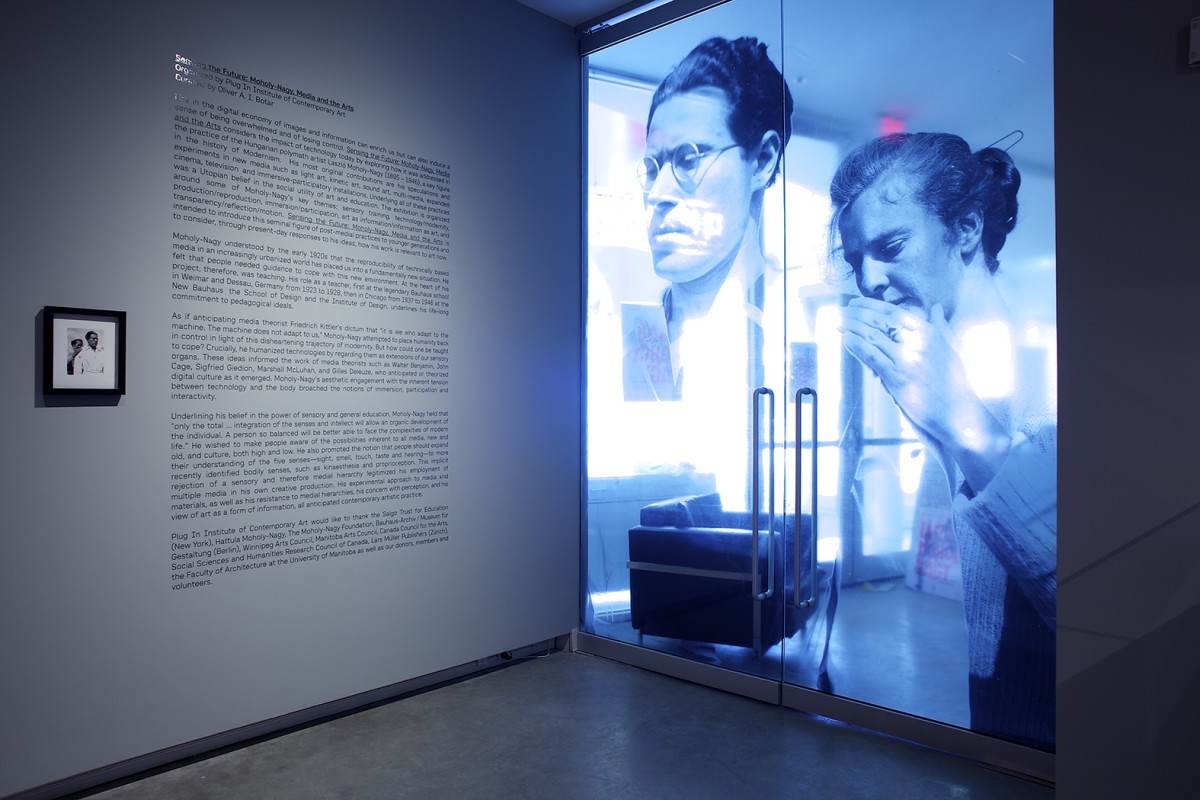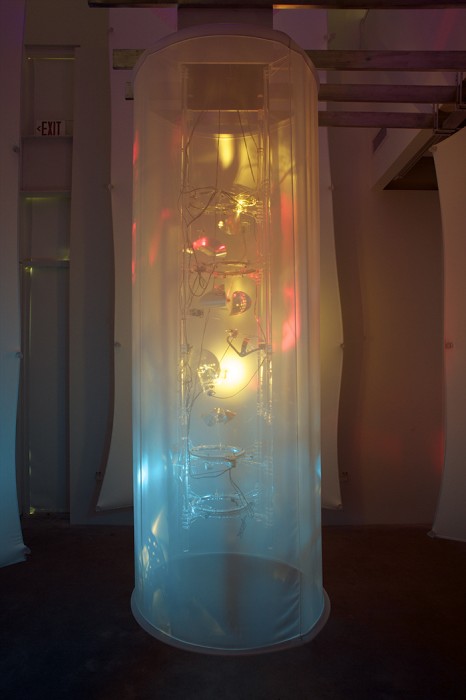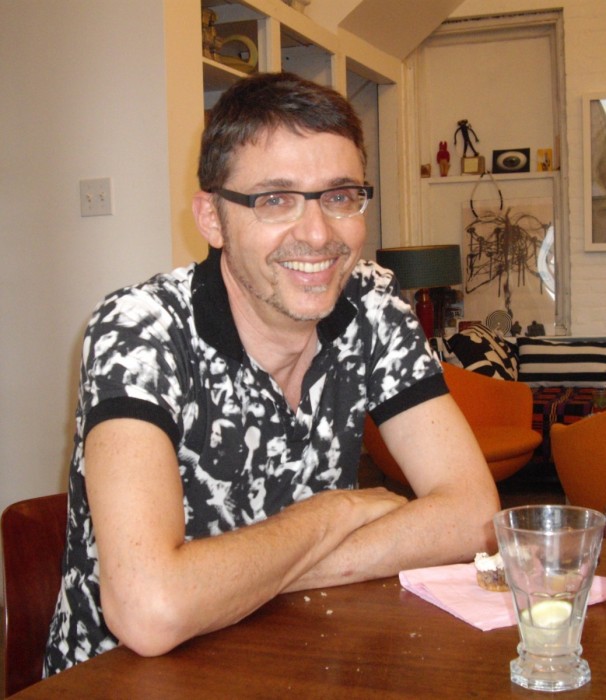
A continuous future of the senses: Art exhibit spotlights response to technology
Check your Twitterfeed lately? Updated your status on Facebook? Posted to Instagram, lost hours on Pinterest or reddit?
The list of social media goes on and on. In a mere decade, we’ve gone beyond the convenience of instant communication to immersive social environments — and sometimes it can all be a little overwhelming.
Art history prof Oliver Botar has just curated an art exhibition that addresses the idea of technology overload. The surprise? The exhibit centres on the work of a European modernist artist who died in 1946.
“Sensing the Future: Moholy-Nagy, Media and the Arts,” which opened at Winnipeg’s Plug In ICA on March 8, revisits the work of Hungarian artist, thinker and educator László Moholy-Nagy (1895-1946). It brings together rare works by Moholy-Nagy and juxtaposes those of contemporary artists whose own work has been influenced by — or responds to — the rich imaginative fields generated by this innovative polymath. Many of the contemporary works were commissioned for the show.
Botar: ‘Here we are in 2014, and we are overwhelmed by the constant barrage of technology; things haven’t really changed that much. This process of change has been going on since … the late 18th century.’
As Botar says, “Here we are in 2014, and we are overwhelmed by the constant barrage of technology; things haven’t really changed that much. This process of change [and feeling overwhelmed by new technology] has been going on since the industrial revolution, in the late 18th century.”

Installation detail, Lancelot Coar and Patrick Harrop, Polycinema (after ideas of László Moholy-Nagy), 2014. // Photo: William Eakin.
He points to the difference between a rural lifestyle and an urban one — the growth of cities was another important facet of the era. “The sounds, sights, smells one encounters — it can feel overwhelming.
“Since modernity began and since the industrial revolution, there’s always been a lot of new technology to adapt to. You can imagine when people started using telegraphs: the idea of not being able to communicate with people far away instantaneously and then suddenly being able to: it’s a huge difference! It must have been a big adjustment for people.
“Our time — with its proliferation of technologies — is similar to that time of the 20s.”
And being in Berlin in the 20s, Moholy-Nagy was writing and thinking about these issues, he explains.
In fact, the current Plug In show, which will also travel to Berlin, is all about this question of adjustment to technological change, in part because people’s difficulty with it was a concern of Moholy-Nagy, he says.
Not only was the artist fascinated by the effects of and possibilities for technology, he was committed to — even beyond artmaking itself — “the Utopian reform of society through the transformation of individuals,” as the exhibition notes read. “To this end, the artist felt that people needed varied sensory stimulation in order to become full human beings living in an increasingly technologized world.”
Botar says he became increasingly interested in this later period of Moholy-Nagy’s oeuvre.
“He started theorizing about new media — and he wrote a lot about technology, including the pace of technological change. He saw all media being of equal value — so he didn’t see paintings, for instance, being inherently more valuable, than photography, or photography as being inherently more valuable than abstract light projections [such as he did].”
This was very unusual for his time, adds Botar.
Moholy-Nagy was trying to address the problem of technological change, and people’s difficulty in adjusting to that, trying to help with that.
“He was trying to address the problem of technological change, and people’s difficulty in adjusting to that, trying to help with that.
“He realized that artists are very well positioned to help educate people to be able to use their senses — all their senses — more fully. To be able to borrow, as an artist, from this environment, the fast-paced, multi-sensory environment of the city.” To this end, Moholy-Nagy introduced concepts like “sensory training,” the idea that one could become accustomed to — and even educated by — sensory exposure through artwork.
Underlines Botar, “He was one of the first to theorize an end to the hierarchy of media — and also an end to the hierarchy of the senses. People have always put the visual first. And visuality was very important for him — and for visual art — but it’s not the only sense. There’s also acoustic elements; and he proposed olfactory elements.”
Placing no premium on the visual in art, or on the visual arts per se, he saw art as one kind of information, Botar continues.
Moholy-Nagy believed that “only the total … integration of the senses and intellect will allow an organic development of the individual. A person so balanced will be better able to face the complexities of modern life.”
The contemporary pieces in the show are as unusual as those by Moholy-Nagy: they include an olfactory poem, text set over a glass door and works that are interactive, with light-and-sound sensors and displays.
Scroll down for a slide show of exhibition views and some of the works included.
***
[rev_slider Moholy-Nagy-exhibition-Mar2014]
***
Moholy-Nagy understood by the early 1920s that the reproducibility of technically based media such as photography and film, the easy production of facsimiles of artworks, the proliferation of image, sound and information through mass media, and an increasingly urbanized world have placed us into a fundamentally new situation. The Futurists wrote of simultaneity, the parallel stimulation of our senses from multiple sources. Moholy-Nagy felt that people needed guidance to cope with this simultaneous environment. At the heart of his project, therefore, was teaching. His role as a teacher, first at the legendary Bauhaus school in Weimar and Dessau, Germany from 1923 to 1928, then in Chicago from 1937 to 1946 at the New Bauhaus, the School of Design and the Institute of Design, underlines his life-long commitment to pedagogical ideals. (from the exhibition description)
***
His most original contributions are his speculations and experiments in new media such as light art, kinetic art, sound art, multi-media, expanded cinema, television, and immersive-participatory installations. Underlying all of these practices was a Utopian belief in the social utility of art and education. The exhibition is organized around some of Moholy-Nagy’s key themes: sensory training, technology/modernity, production/reproduction, immersion/participation, art as information/information as art, and transparency/reflection/motion. (from the exhibition description)
***
Discovering the “utopian and dreamer” László Moholy-Nagy sparked for Botar what has become a decades-long project on the work of this early 20th century Hungarian modernist artist.
Botar got the cultural history bug back in grad school, auditing and then enrolling in art history courses while completing his master’s of city planning. He switched to art history for his PhD and soon became interested in Middle European modernism.
“Partly because I know the language, having grown up speaking [Hungarian] in the home — so I have that background,” he explains. “I wanted to use that knowledge.”
He’s done previous projects on Moholy-Nagy, including the 2006 NYC exhibition that showed at the City University of New York (CUNY) and travelled on to Rutger’s University and Hungary. A catalogue of the show was also published in a Hungarian edition.
“He wasn’t the only dreamer, the only utopian of that period — it was very typical of the 30s and 40s — but he was really ahead of his time, in many ways.”
For Botar, whose research includes the history of art as it relates to new media — he teaches a course on it, in which Moholy-Nagy figures prominently — interest has more recently run to the artist’s influence on new media. At first, he says, his interest was more general, with a focus on the artist’s early period.
One key to his interest, says Botar, is that “during a relatively short career, [Moholy-Nagy] put forward more ideas that came to pass in the future in one way or another than almost any other artist I know of from that period.
“He wasn’t the only dreamer, the only utopian of that period — it was very typical of the 30s and 40s — but he was really ahead of his time, in many ways.”
– Mariianne Mays Wiebe
***
“Sensing the Future: Moholy-Nagy, Media and the Arts” runs until June 1 at Plug In ICA. See more here.
There will be a Curatorial walkthrough with Oliver Botar on Saturday, May 31 from 1:00 to 3:00 PM at Plug In ICA, 460 Portage Avenue, Winnipeg, Canada
In addition to works by László Moholy-Nagy, artists whose works are included in this exhibition include U of M architecture prof Eduardo Aquino (who also designed the show), U of M architecture prof Lancelot Coar; U of M sessional instructor in the Faculty of Architecture Ken Gregory, U of M architecture prof Patrick Harrop (Winnipeg); U of M School of Art alumna Erika Lincoln, and the team of Guy Maddin, U of M film maker in residence.







